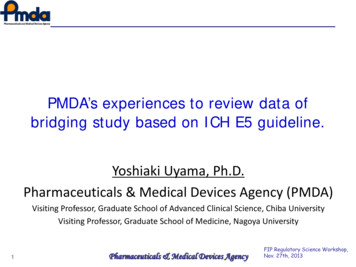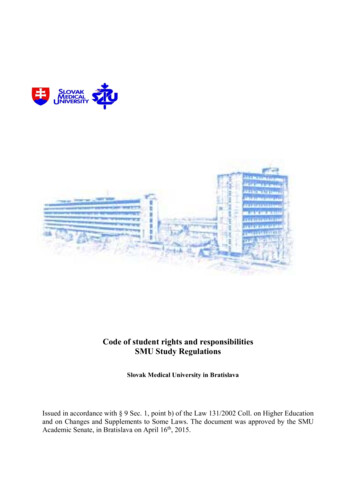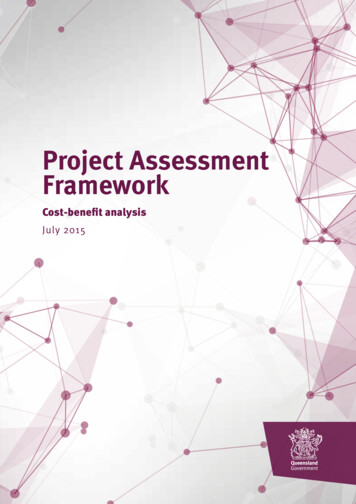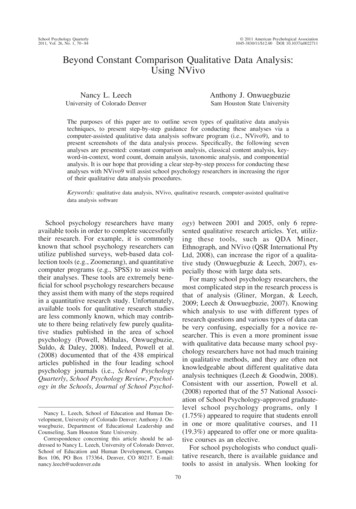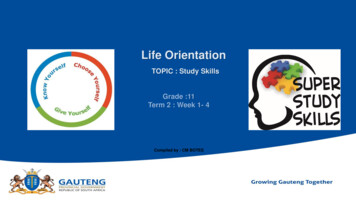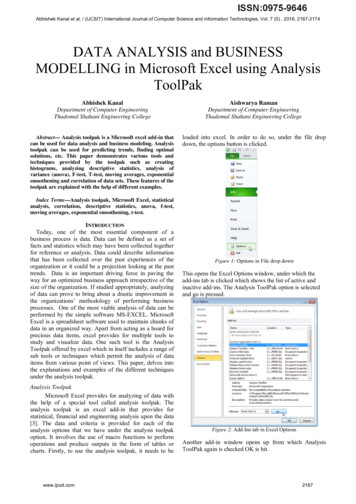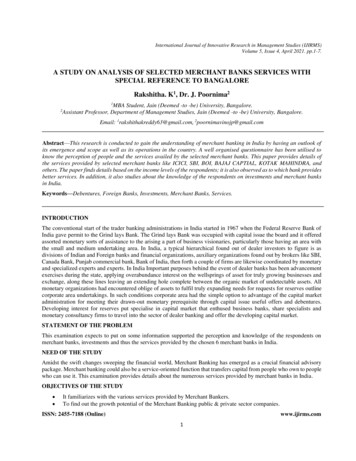
Transcription
International Journal of Innovative Research in Management Studies (IJIRMS)Volume 5, Issue 4, April 2021. pp.1-7.A STUDY ON ANALYSIS OF SELECTED MERCHANT BANKS SERVICES WITHSPECIAL REFERENCE TO BANGALORERakshitha. K1, Dr. J. Poornima21MBA Student, Jain (Deemed -to -be) University, Bangalore.Assistant Professor, Department of Management Studies, Jain (Deemed -to -be) University, Bangalore.2Email: 1rakshithakreddy63@gmail.com, 2poornimavinojp@gmail.comAbstract—This research is conducted to gain the understanding of merchant banking in India by having an outlook ofits emergence and scope as well as its operations in the country. A well organised questionnaire has been utilised toknow the perception of people and the services availed by the selected merchant banks. This paper provides details ofthe services provided by selected merchant banks like ICICI, SBI, BOI, BAJAJ CAPTIAL, KOTAK MAHINDRA, andothers. The paper finds details based on the income levels of the respondents; it is also observed as to which bank providesbetter services. In addition, it also studies about the knowledge of the respondents on investments and merchant banksin India.Keywords—Debentures, Foreign Banks, Investments, Merchant Banks, Services.INTRODUCTIONThe conventional start of the trader banking administrations in India started in 1967 when the Federal Reserve Bank ofIndia gave permit to the Grind lays Bank. The Grind lays Bank was occupied with capital issue the board and it offeredassorted monetary sorts of assistance to the arising a part of business visionaries, particularly those having an area withthe small and medium undertaking area. In India, a typical hierarchical found out of dealer investors to figure is asdivisions of Indian and Foreign banks and financial organizations, auxiliary organizations found out by brokers like SBI,Canada Bank, Punjab commercial bank, Bank of India, then forth a couple of firms are likewise coordinated by monetaryand specialized experts and experts. In India Important purposes behind the event of dealer banks has been advancementexercises during the state, applying overabundance interest on the wellsprings of asset for truly growing businesses andexchange, along these lines leaving an extending hole complete between the organic market of undetectable assets. Allmonetary organizations had encountered oblige of assets to fulfil truly expanding needs for requests for reserves outlinecorporate area undertakings. In such conditions corporate area had the simple option to advantage of the capital marketadministration for meeting their drawn-out monetary prerequisite through capital issue useful offers and debentures.Developing interest for reserves put specialise in capital market that enthused business banks, share specialists andmonetary consultancy firms to travel into the sector of dealer banking and offer the developing capital market.STATEMENT OF THE PROBLEMThis examination expects to put on some information supported the perception and knowledge of the respondents onmerchant banks, investments and thus the services provided by the chosen 6 merchant banks in India.NEED OF THE STUDYAmidst the swift changes sweeping the financial world, Merchant Banking has emerged as a crucial financial advisorypackage. Merchant banking could also be a service-oriented function that transfers capital from people who own to peoplewho can use it. This examination provides details about the numerous services provided by merchant banks in India.OBJECTIVES OF THE STUDY It familiarizes with the various services provided by Merchant Bankers.To find out the growth potential of the Merchant Banking public & private sector companies.ISSN: 2455-7188 (Online)www.ijirms.com1
IJIRMS — Volume 5, Issue 4, April 2021LIMITATION The study is based on secondary data. So, the limitations of secondary data may also creep in and have an impacton the present study also.The study considers data of only limited duration of time.Study is based on sample of 6 Merchant Bankers; hence it does not depict the overall pictures of merchantBanking in Indian.LITERATURE REVIEWWaghmare Shivaji (2015): Globalization made whole Indian economy open which features a multiple role within thefinancial services. Now a day’s government open the door of investment within the area of insurance and bank. whichgive competitive environment for present player? Merchant banking is an innovative term introduced by full-servicebank. The necessity for the merchant banking is pronounced by banking commission (1972). Merchant banking offer feebased and non-fee-based services like loan syndication, underwriting, project promotion, advisory to small and mediumsavers. In India merchant banking work under SEBI.Dr. Jyoti Lahoti (2016): Merchant banking is service provided by financial organization which helps within theeconomic development of the country. Merchant banking provides various services like portfolio management, loansyndication, and issue management. Merchant banking may be a combination of consultancy services and banking. Ithelps within the business unit. It also helps to extend the fund and to expand the business.Dr. Singh and Dr. Saxena (2017): Merchant banking consists of wide selection of monetary activities and financialorganization acquirer called “Accept and issue house”. Because merchant banking acting as broker and principle.Merchant banking features a long- term approach concerned with each investment opportunity and provides right adviceto every client of the corporate. Merchant banking may be a service provided by many financial institutions to extendgrowth of corporate sector which reflect into Indian economy. Merchant banking may be a combination of consultancyservices and banking.CS Gowtham (2017): Merchant banking issue share, debentures, loan to their clients. This finance is employed for brandspanking new business or to expand the business, to switch the business. Merchant banking not only provides finance butalso provide right path with reference to SEBI. Shreyas B.S: Merchant banking contains wide selection of monetaryactivities. acquirer is named “Accepting and issuing house” Merchant banking is rapidly growing in Indian economy.The SEBI which provides overall view of present and past. Merchant banking is oldest within the primary market and itsbright future in coming years.METHODOLOGYThe present analysis is exploratory in nature. the info for this research has been collected through self-Administration.thanks to time limitation and different constraints direct personal interview study technique is employed. A structuredform was farmed because it consumes less time length and is incredibly necessary from the purpose of read of data, easierto tabulate and interpret. a lot of ever respondents favor to provide direct answer.Data Collection:Data collection is the process to gather information about the relevant topic research, Data Collection usually takes placeearly in an improvement project, and is often formalized through data collection plan which often contains the followingactivity: Pre collection activity on goals, target data, definitions and methods.Collection of Data.Presenting findings involving some form of sorting analysis.For accomplishing the objective of this study, both Primary and Secondary data have been used.Classification of dataPrimary Data:The study is largely based on the primary data which has been collected through the structured Questionnaire Method.Questionnaire:The study is basically supported the first information that has been collected through the structured form technique.2
A Study on Analysis of Selected Merchant Banks Services with special reference to BangaloreQuestionnaire: The data has been collected by administering a structured schedule of queries. The queries are typicallyframed by 5-point Likert Scale. For this study purpose form technique is employed to gather the first information. Thisform is self-administrated form, and it is divided into 2 sections – Section A and Section B. Section A consist of the questions regarding Personal Information. For E.g., Name, Age, Gender, Qualification,Marital Status, Occupation.Section B consist of the questions which fulfil the research objectives.Secondary Data:This type of information has already been collected by somebody else and has already competent applied math method.Sources of assortment of Secondary information Internet, Journal, News Papers, BooksSample Design:The complete study of all items in the population is known as a census inquiry. Sample is a group of few items, whichrepresents the population is or universe from where it is taken. The size of sample is 30 respondents.Sampling Size:The sample size of the study was 30. The responses were captured from respondents on a 5-point Likert scale.Sampling Technique:The sampling method was Judgment Sampling (only those respondents were chosen who had some knowledge aboutmerchant banking).RESEARCH PLAN:Data SourcePrimary Data & Secondary DataResearch ApproachSurveyResearch InstrumentQuestionnaireMethod of ContactE mailsSample Size30 RespondentsDATA ANALYSIS AND INTERPRETATION1. The annual income of the respondentsNull hypothesis the annual income of the respondents is in the range of 1.5 to 3 lakhs.Alternative hypothesis the income of the respondents are 3 lakhs to 5 lakhs.Based on the survey conducted it is observed that the income of respondents ranging from 3 lakhs to 5 lakhs is more (i.e.,43.33%). Hence the null hypothesis is rejected.3
IJIRMS — Volume 5, Issue 4, April 20212. Do respondents do savings for passive income?7%YES7%NOMAYBE86%Null hypothesis the respondents save for passive incomeAlternative hypothesis the respondents do not save for passive incomeBased on the survey conducted it is observed that most of the respondents like to save for passive income (i.e., 86.67%).Hence the null hypothesis is accepted.3. What % of respondent’s income do they save for investing5% -10%13%10%- 20%47%20% & ABOVE40%The above chart depicts that the 46.67% of the respondents save 5 – 10% of their income to invest, 40% of the respondentssave 10 – 20% they save and 13% of them save 20% and above.Null hypothesis the respondents save 5%-10% of their income for investments.Alternative hypothesis the respondents save 10%-20%of their income for investments. Based on the survey conductedit is observed that most of the respondents (i.e., 46.6%) save 5 to 10% of their savings. Hence the null hypothesis isaccepted.4. Factors preferred by respondents while investing.SAFETY17%33%7%43%4HIGHRETURN
A Study on Analysis of Selected Merchant Banks Services with special reference to BangaloreNull hypothesis the respondents prefer safety while investingAlternative hypothesis the respondents prefer high returns while investingBased on the survey conducted it is observed that most of the respondents (i.e., 46.6%). prefer higher returns over safety,liquidity, and risks. Hence the null hypothesis is rejected.5. If the respondents take any advice before investingYESNO17%MAY BE56%27%Null hypothesis the respondents prefer taking advice before investing.Alternative hypothesis the respondents do not take any advice before investingBased on the survey conducted it is observed that most of the respondents (i.e., 56.67%). prefer taking advice beforeinvesting. Hence the null hypothesis is accepted.6. If the respondents are aware about merchant bankingYESNO23%77%Null hypothesis the respondents are not aware about merchant bankingAlternative hypothesis the respondents are aware about merchant bankingBased on the survey conducted it is observed that most of the respondents (i.e., 76.67%) are aware about merchantbanking. Hence the null hypothesis is rejected.5
IJIRMS — Volume 5, Issue 4, April 20217. The respondents are satisfied with the services provided by their banksYES20%NO80%Null hypothesis the respondents are not happy with the services provided by their banksAlternative hypothesis the respondents are happy with the services by their banksBased on the survey conducted it is observed that most of the respondents (i.e.,80%) are happy with the services providedby their banks. Hence the null hypothesis is rejected.FINDINGS Respondents are interesting in saving their annual income for the passive income which they will use it in thefuture in their retirement for the independence on the others.Respondents founds that fixed deposits type of savings is better than mutual fund because mutual fund is riskieras compare to fixed deposit.Respondents wants to invest in the fixed deposits because it is safer than mutual fund.Respondents observe that fixed consume time than mutual fund for the better return.RECOMMENDATIONS Merchant banker should advertise as much as possible for the awareness among the public and inform themabout the investment option.Merchant banker ought to educate the investors concerning the chance management and correct coming up withfor the investment.They must conjointly give technical, money & social control services & facilitate the corporate to line up amemoir.The assistance should be provided for the equity support through loan support to supplement this may beextended.It is better for merchant banks to bring professionalism in their merchant banking functions. This will enablemerchant bankers to gain excellence in their performance.A very large number of merchant bankers make it difficult for SEBI to monitor them. It is better to evolve andimplement sound and sensible eligibility criteria for people to quality as merchant banks.Merchant banks do engage in extending leasing and hire purchase services to their corporate clients and generaterevenue in the form of the lease rentals and hire purchase instalments.CONCLUSIONThe Merchant Banking industry in India which started with large foreign banks and firms and were then adopted byIndian Commercial Banks and firms as well, have faced various challenges over the years. This study provides details onthe profile of select Merchant Banks in India belonging to public and private sectors, to find out the growth potential ofthe Merchant Banking public & private sector companies, the respondents prefer investing in passive income, and it isalso observed that not much of the respondents are aware about the service availed by merchant bank.6
A Study on Analysis of Selected Merchant Banks Services with special reference to BangaloreREFERENCES ia.in*****7
A Study on Analysis of Selected Merchant Banks Services with special reference to Bangalore 5 Null hypothesis the respondents prefer safety while investing Alternative hypothesis the respondents prefer high returns while investing Based on the survey conducted it is observed that most of the respondents (i.e., 46.6%). prefer higher returns over safety,

